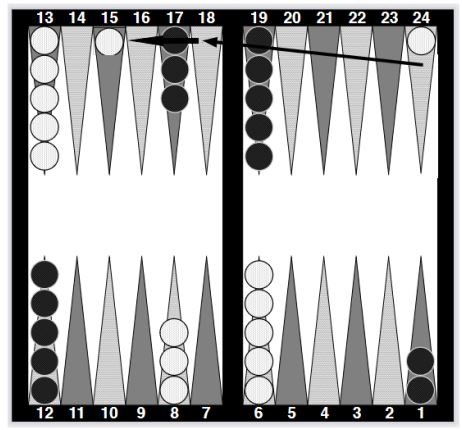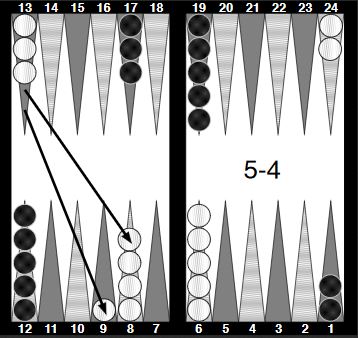Last updated on April 21, 2024
In this Deluxe Backgammon post for beginners, we are going to take a closer look at the 5-4 opening move. It is not one of the preferred opening rolls as it won’t secure a key point. There are three widely accepted plays for this roll. One is a clear gamble with a racing strategy. Another pushes builder’s down from the mid-point. The last looks for a balanced play on both sides of the board. We will analyse each of the plays below. Ideally, you should be familiar with all three and play the one that best fits your playing style and the state of the match.
The three most popular ways to play the 5-4 opening roll are:
24/15, where a running game strategy is applied and you attempt to escape one of the back checkers to the outer board.
13/9, 13/8, where you bring down two builders from the mid-point into your outer board.
24/20, 13/8, where you develop both sides of the board. Firstly, by moving a back checker to the opponent’s 5-point. Second, you safely move a checker down from the mid-point to the 8-point.
We will take a look at the pros and cons of each of these moves in turn.
24/15
There is an identical option for the 6-3 opening move. This move initiates a running or racing strategy by escaping one of the back checkers early in the game. The goal is to move this checker to safety on the next move or to cover it with a 6-3 or 5-4 roll. However, your opponent will be targeting the blot on the 15-point in the hope of eliminating your racing advantage.
The downside of this move is that your opponent will be able to hit the blot on 13 rolls out of 36 (36%). In just over a third of the time the checker will be hit, you will have a checker on the bar and your opponent has a useful builder in your outer board. The question is really whether or not the racing advantage is worth the risk. The plus side is that 64% of the time your blot will be missed and even if you are hit you have plenty of time to recover.
13/9, 13/8
The tactic for this play is to bring down checkers from the mid-point to positions where they can be used to build home board points. The 13/9, 13/8 move leaves an excellent chance of securing the five-point or bar-point on the next throw. It provides an attacking option if your opponent brings a back checker forward to the 5, 4 or bar-points. However, the problem with this move is that it moves a lot of checkers forward in the early stages of the game. It leaves just one spare checker on the mid-point. It is often useful to have a couple of spare checkers on the mid-point to defend your outer board if your opponent tries to escape a back checker. These spare checkers help provide flexibility, giving you more options on subsequent rolls.
24/20, 13/8
The 24/20, 13/8 is a balanced play that develops both sides of the board in a single move. In subsequent rolls, you would hope to secure the blot on the 20-point and create an advanced anchor. This would create problems for your opponent as you would have a secure landing point for checkers that are hit. In addition, this would disrupt your opponent’s ability to construct an effective prime.
The problem with the 24/20 move is that the 20-point, the opponent’s 5-point, is the most valuable point on the board for your opponent and they will do anything to hit the blot. It would be especially bad if they rolled a 3-1, where they can hit and secure the 5-point, beginning the start of a home board prime. However, should they hit without securing the 5-point, they are at risk of being hit on return. This would send them back 20 pips in the race. It is a provocative move, the 24/20, which almost certainly is going to ensure some heavy-hitting action from both sides to secure the point. In the meantime, the 13/8 is a safe move bringing a builder down from the mid-point to the 8-point.
Comparison
How do the three options compare? In XG Mobile Backgammon rollouts, all three options are favourable with the 24/20, 13/8 coming out slightly on top. Closely behind is the 24/15 racing option. In third place is the 13/9, 13/8. The difference between the three is so small that any would be considered a reasonable play. The slight edge to the 24/20, 13/8 might be because it is splitting the back checkers early before the opponent’s home board becomes too strong. By moving a back checker forward, you not only try to acquire a valuable point, but you also create danger for your opponent if they want to bring builders into their outer board.
Experiment with all three options and determine which of them best suits your style of play.
Related content
Backgammon opening moves, a simple list.
Backgammon opening theory at Wikipedia.




I have played backgammon for decades, I have always played the 24/15, applying a racing strategy. After reading this post I’ll try 24/20, 13/8 since the rollout suggests a slight edge. My backgammon can’t get any worse!
Hello, I am a backgammon player and looking for advanced backgammon situations to study.
Hi Ed, take a look at our Deluxe Backgammon Playing Guides. In particular, you might be interested in the Advanced backgammon strategies post. Thanks for commenting, Jason.
The third option is widely accepted as the most balanced move if you’re unsure which strategy to undertake. It moves a back checker off of your five-point, providing a greater offensive and defensive flexibility if necessary. You can cover the blot on your eight-point by later rolling a 4-3. Additionally, it still leaves a builder on your mid-point, giving you more chances to build home board points in the mid-game.
Overall, this is an excellent post on how to play the 5-4 opening move in backgammon. It highlights the pros and cons of each play so players can choose the one that best fits their style of play. This is incredibly useful for players who are just getting started with backgammon.